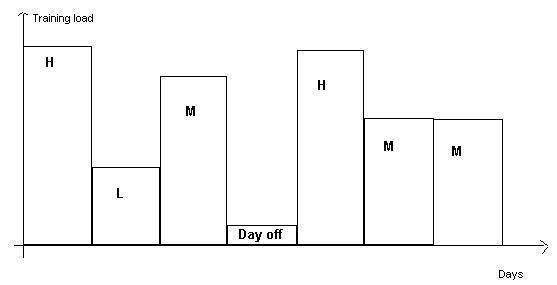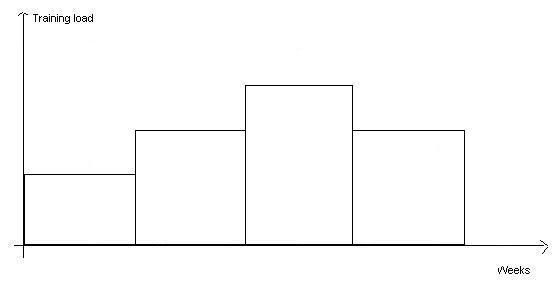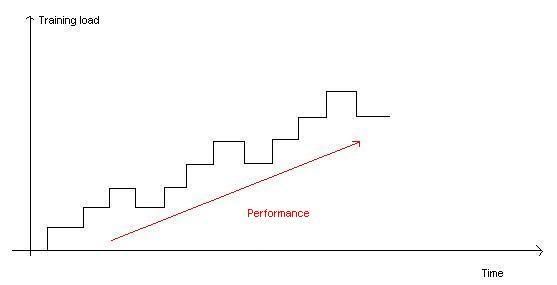2. Methodology of training
2.1 The principle of planning in training
As we saw earlier, recovery is essential for adequate performance. However, complete recovery after a hard day of training may last more than 48 hours, and training every other day is not really an option for elite performance. That's why we must alternate easy days with hard days, as illustrated below:
 Figure E: Microcyle
Figure E: Microcyle
Each rectangle represent one day. H represent hard days, M: medium days, L: easy days, and we plan a day off on the fourth day. There are many ways to alternate harder days with easier days. A harder week would have more hard and medium days, and less easy days, etc. A week like this is usually called a microcycle.
In order to progressively increase the load in training (section 1.5), we have to plan harder and easier weeks; we plan a macrocycle:
 Figure F: Macrocycle
Figure F: Macrocycle
This is the typical macrocycle: 3 gradual increases in load, followed by an easier week. As seen in section 1.2, the load of training can be varied with duration, frequency, intensity and density.
Over a longer period, this is how macrocycles would add up:
 Figure G: Gradual increase in load and performance
Figure G: Gradual increase in load and performance
If well planned, then performance would gradually increase.
2.2 Annual Periodisation
You can't use high volume and high intensity at the same time. However, both are important to maximize performance. This is where annual periodisation comes in: we can split the year in different periods with different focuses.
Here is an annual "plan" for a powerlifter with one major competition at the end of the year (MS Paint isn't exactly the best software to build graphs):
 Figure H: Annual plan 1
Figure H: Annual plan 1
We have a deloading period at the end of the year, which is followed by adaptation training at the beginning of the next year; this period is used to rehabilitate the tendons and all connective tissues into heavy training. The highest volume of the year is then seen during the hypertrophy period, where the athlete will develop myofibrillar and sarcoplasmic hypertrophy. The rest of the year will be used for maximum strength training, since this is the main goal of this sport.
An annual "plan" for a powerlifter with 2 major competitions, one mid-season, then one at the end of the year will be similar to the first one, but we would have 2 deloading periods, which would result in two peaks. The primary peak would be at the end of the season.